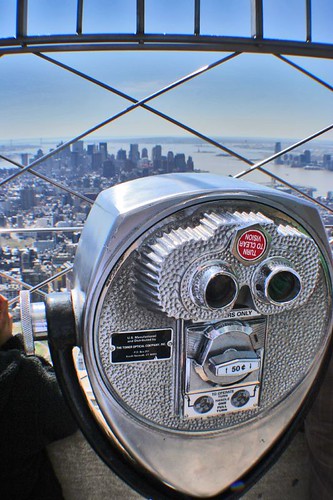 It struck me the other day, while reading one of Springwise's increasingly frequent posts on the mass customization of travel, that the types of travel apps and sites being developed right now to personalize the urban travel experience could have a profound impact not just on how we visit cities, but on how cities themselves function, as well.
It struck me the other day, while reading one of Springwise's increasingly frequent posts on the mass customization of travel, that the types of travel apps and sites being developed right now to personalize the urban travel experience could have a profound impact not just on how we visit cities, but on how cities themselves function, as well.Urban travel has long been a two-sided coin, with time in a new city being divided (in different ratios, depending on the tourist) between the standard landmarks like the Empire State Building or the Forbidden City, and the day-to-day urban world that exists on the edges of guidebooks; think of Brooklyn back in the 1990s, or Beijing's fast-evaporating hutongs today -- places to which people are drawn to observe a quotidian rhythm different from their own: to experience the spectacle of the extraordinary-ordinary.
The Postcard City and the Real City are invariably pitted against each other in a battle for the urban tourist's limited time. But as cities grow bigger and bolder on our increasingly urban planet, it seems fair to assume that greater and greater numbers of tourists will make their way down the streets of cities that they do not call home; as such, the traditional landmarks and attractions will become more and more crowded, making the prospect of tooling around lesser-seen corners of the metropolis an increasingly attractive option for visitors.
The aforementioned trend blog has spotted some real doozies lately: a site that allows you to navigate cities by mood (Could Yelp-like testimonials about certain blocks, streets, parks, or even whole neighborhoods define or even change the mood of a given place?); another that uses personal data to create personalized guidebooks (Would the diversity of interests force travel publishers to re-think the meaning of the term "attraction?" I.E. cyclists' internationally competitive quests to speed up the steepest slopes could reboot the way a whole subculture navigates hilly cities like San Francisco, Pittsburgh, Guilin, and Lisbon); and another that helps you track down a hot scene at the last minute with crowdsourced GPS data (Anybody up for an impromptu, flashmob-style block party?)
By making wandering off the beaten path more enticing, the customization of the urban tourism experience has the potential to distribute visitors more evenly around the city than old-school printed-paper guides, with their restricted map insets and hyper-selective restaurant listings. But does this dispersal of small-time explorers legitimize or cheapen the Real City? It seems to echo ongoing arguments about gentrification; after all, while the presence of individual tourists at specific sites is fleeting, their combined influence can be very powerful over time. And, while the carving of initials into a famous landmark is a time-honored tradition (as old as the very idea of landmarks), tourists will soon be able to carve their very presence into a city in the unpredictable paths that they cut through it, shifting not only the way that other visitors, but the very citizens of the city in question, navigate and experience a place.
(Image from Flickr user LondonSLR. The original full-sized versions can be viewed by clicking the photo.)

2 comments:
Maybe it could the other way.... In Venice and other places, residents avoid the well worn mobility paths and routes of tourists, practicing a mobility of avoidance. They avoid the times and points of congestion such as when tour groups wait to board local water taxis or times when tourist flood Saint Marks.. a tourist avoidance App..useful :)
Something tells me that we all do this inherently. I live in a corner of Beverly Hills, and do my best to avoid the "Beverly Hills" that everyone thinks of when they hear the name. I think each city has multiple identities and constituencies. When I do have to make my way up into the Rodeo Drive / "Pretty Woman" part of town, I usually have a specific unavoidable purpose. I am certainly like the Venetians who do their best to avoid the touristy congestive spots and times.
Great post. Adding you to my reading list...
Thanks.
Post a Comment